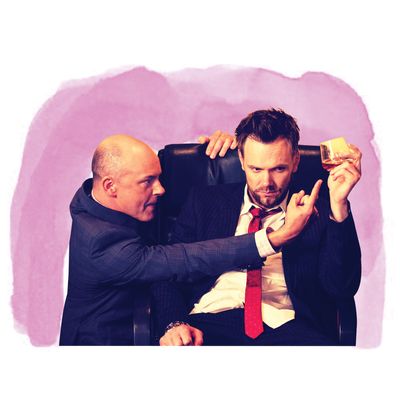
Ahhhhh. Now, that’s more like it.
That’s not the keenest critical summary of the fifth season of Community. But that’s how you’ll feel if you, like me, think the sitcom became an unsatisfying photocopy of itself after Dan Harmon, its creator and driving force, was pushed out over complaints about his volatile management style. The show’s Harmonless fourth season produced a few memorable installments; the best were probably the puppet episode (“Intro to Felt Surrogacy”) and the season finale (“Introduction to Finality”) that could have doubled as makeshift series finale in case NBC and Sony pulled the plug. But even at its best, the Harmonless Community still felt off, like a cover band doing another group’s material. Some alchemical agent was awol. Now it’s back, thank goodness, and even if you didn’t know Harmon was in charge again, you’d sense it. It’s just mysteriously there, like a stirring in the Force that would trigger a Star Wars riff by the series’ resident pop-culture addict, Abed (Danny Pudi)—if Abed needed a pretext to babble about sci-fi.
January 2’s fifth-season premiere, co-written by Harmon and Chris McKenna, is fittingly titled “Repilot.” “This could be like Scrubs season nine—a revamp, a do-over,” says Abed, who rightly suggests that Joel McHale’s preening lawyer Jeff Winger become a professor because it would help make a fifth season more dramatically credible. Except for Chevy Chase’s moneybags racist Pierce, who got axed, seemingly because no one at Community could stand the actor, every notable student character is back at Greendale Community College, even though they all theoretically graduated: the neurotic hyperachiever Annie (Alison Brie), the perpetually nonplussed Christian Shirley (Yvette Nicole Brown), the flaky bombshell Britta (Gillian Jacobs), the high-school sports star turned Abed ally Troy (Donald Glover), and Jeff, who convinces the others that four years at Greendale ruined them and they should sue for damages. “I don’t believe in evil,” Britta says, “but this school clearly got a finger up its butt as a child.” Neither she nor anyone else really believes this vengeful line, though. They’ve just fallen under the dark spell of Jeff, who’s reluctantly in cahoots with his old law-firm partner Alan Connor (Rob Corddry). Will their wicked plot succeed? Of course not; this is Community, which resuscitates the endless-reboot aesthetic of sixties sitcoms while spoofing it.
Everything’s more exact and purposeful than last year: the shots, the cuts, the lines, the pauses between lines. More than anything, though, there’s a creeping sense of melancholy that keeps threatening to morph into panic, even darkness. This is true to form: Harmon’s form. Community’s dominant mode was always peppy and upbeat, but even in its sprightliest half-hours it was perched on the knife edge of hysteria, and when it tipped over, it didn’t feel like a put-on. The jokes stung a bit, sometimes a lot. And when the characters’ dreams got dashed, or when they gave into petty impulse and betrayed one another, it hurt more than it should, considering how up-front Community always was about pulling back the curtains and showing you how the play was imagined. “I think our opinions on popular culture are fed to us by machines designed to criminalize human autonomy,” says Britta in a rare burst of eloquence that doubles as a critique of the show you’re watching.
Harmon has un-facetiously likened the show to Gilligan’s Island—a construct that was never meant to represent anything like a real place or experience. The scripts contorted themselves to become comments on stories and storytelling, memories and fantasies and alternate realities. The sub-reference-laden dialogue was almost pointillistically dense: shrapnel from a Wikipedia explosion. (Trying to guess the identity of Annie’s boyfriend in season two’s “Asian Population Studies,” her friends name-dropped Vince Vaughn, Michael Chiklis, Anderson Cooper, Johnny Depp, and Optimus Prime in the space of 30 seconds.) But it all felt real, or “real,” because the characters’ relationships and feelings were grounded and pure. There’s genuine bitterness beneath the show’s lively pantomime of disappointment—a fear that by any of the usual American yardsticks Greendale’s students and faculty are social dregs, half-studying in classes half-taught by half-experts, filling up hours that might otherwise be claimed by jobs they hate and don’t believe in—like Annie’s work for Futurza, a pharmaceutical company whose pills she nervously pops. (“They invented fibromyalgia and the cure for fibromyalgia,” she explains.)
Nothing in the episodes sent out for review matches peak Harmon dementia, but the signs are promising—particularly an eruption of madhouse chaos in “Cooperative Polygraphy,” an episode that features an Abed theorem, the Crazy Quilt of Destiny, plus a lie-detector plotline that digs into the characters’ buried secrets. “We went in one end as real people and came out the other end mixed-up cartoons,” Jeff says, criticizing Greendale’s broken mediocrity as well as the season-three executive decisions of NBC and Sony. Throughout, there’s a sense that Community is building, or rebuilding, toward something big and bold—that what you’re seeing is not so much a revamp as a restoration. Few live-action sitcoms are so aware of their artificiality and yet so singularly alive.
*This article originally appeared in the January 6, 2014 issue of New York Magazine.


